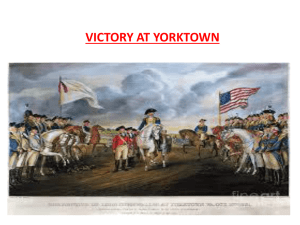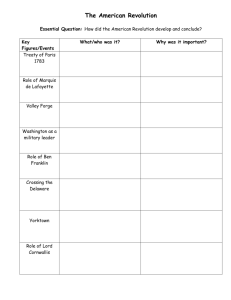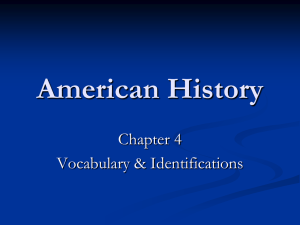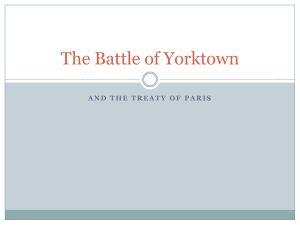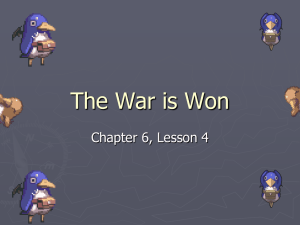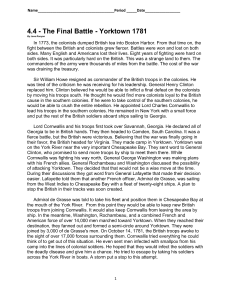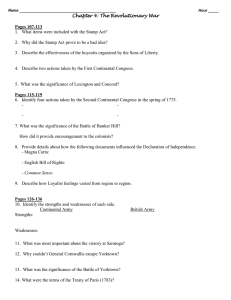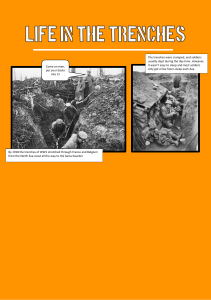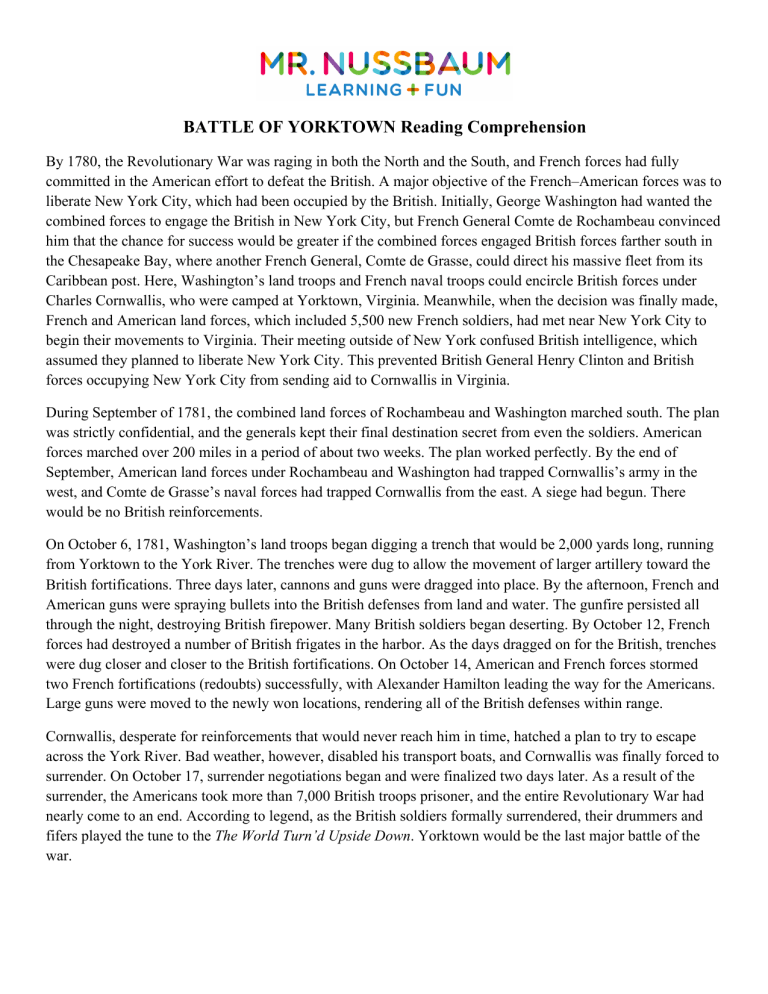
BATTLE OF YORKTOWN Reading Comprehension By 1780, the Revolutionary War was raging in both the North and the South, and French forces had fully committed in the American effort to defeat the British. A major objective of the French–American forces was to liberate New York City, which had been occupied by the British. Initially, George Washington had wanted the combined forces to engage the British in New York City, but French General Comte de Rochambeau convinced him that the chance for success would be greater if the combined forces engaged British forces farther south in the Chesapeake Bay, where another French General, Comte de Grasse, could direct his massive fleet from its Caribbean post. Here, Washington’s land troops and French naval troops could encircle British forces under Charles Cornwallis, who were camped at Yorktown, Virginia. Meanwhile, when the decision was finally made, French and American land forces, which included 5,500 new French soldiers, had met near New York City to begin their movements to Virginia. Their meeting outside of New York confused British intelligence, which assumed they planned to liberate New York City. This prevented British General Henry Clinton and British forces occupying New York City from sending aid to Cornwallis in Virginia. During September of 1781, the combined land forces of Rochambeau and Washington marched south. The plan was strictly confidential, and the generals kept their final destination secret from even the soldiers. American forces marched over 200 miles in a period of about two weeks. The plan worked perfectly. By the end of September, American land forces under Rochambeau and Washington had trapped Cornwallis’s army in the west, and Comte de Grasse’s naval forces had trapped Cornwallis from the east. A siege had begun. There would be no British reinforcements. On October 6, 1781, Washington’s land troops began digging a trench that would be 2,000 yards long, running from Yorktown to the York River. The trenches were dug to allow the movement of larger artillery toward the British fortifications. Three days later, cannons and guns were dragged into place. By the afternoon, French and American guns were spraying bullets into the British defenses from land and water. The gunfire persisted all through the night, destroying British firepower. Many British soldiers began deserting. By October 12, French forces had destroyed a number of British frigates in the harbor. As the days dragged on for the British, trenches were dug closer and closer to the British fortifications. On October 14, American and French forces stormed two French fortifications (redoubts) successfully, with Alexander Hamilton leading the way for the Americans. Large guns were moved to the newly won locations, rendering all of the British defenses within range. Cornwallis, desperate for reinforcements that would never reach him in time, hatched a plan to try to escape across the York River. Bad weather, however, disabled his transport boats, and Cornwallis was finally forced to surrender. On October 17, surrender negotiations began and were finalized two days later. As a result of the surrender, the Americans took more than 7,000 British troops prisoner, and the entire Revolutionary War had nearly come to an end. According to legend, as the British soldiers formally surrendered, their drummers and fifers played the tune to the The World Turn’d Upside Down. Yorktown would be the last major battle of the war. 1.) Why did Rochambeau favor engaging the British in the Chesapeake Bay? a.) Because there were more Patriot and French soldiers stationed there b.) Because the British had evacuated New York City c.) Because the British forces there were weak d.) Because another French fleet from the Caribbean Sea could join their forces 2.) Why were the British confused? a.) The British were expecting Washington to surrender. b.) Cornwallis was not supposed to be in Virginia. c.) They did not know the French had agreed to help the Patriots. d.) It seemed like the Patriots were going to try to liberate New York City. 3.) What does the word “confidential” mean as used below? The plan was strictly confidential, and the generals kept their final destination secret from even the soldiers. a.) confident b.) secret c.) confused d.) illegal 4.) When did the siege at Yorktown begin? a.) When British reinforcements came. b.) When American forces had trapped Cornwallis from the east. c.) When American and French forces had trapped Cornwallis from the west and French naval forces had trapped him from the east. d.) When the British surrendered. 5.) Why did Washington order trenches dug? a.) To store food b.) To move artillery c.) To protect soldiers d.) To hide from the enemy 6.) Which of the following words DOES NOT describe the Siege at Yorktown? a.) violent b.) persistent c.) dangerous d.) unintentional 7.) Based on the passage, which of the following best describes the definition of a siege? a.) A situation on which a smaller army is attacked by a larger army. b.) A situation in which two countries combine forces against another. c.) A situation in which an army encircles or traps another army while attacking it. d.) A battle fought at sea. 8.) What did the Battle of Yorktown ensure? a.) America would become a free country. b.) The British would surrender. c.) The Revolutionary War would soon end. d.) All of the above. 9.) Which of the following could NOT possibly be a title for this passage? a.) The World Turn’d Upside Down b.) The Liberation of New York c.) The Surrender of Cornwallis d.) Details of the Siege at Yorktown 10.) What happened last? a.) July, 1781 b.) 7,000 soldiers were taken prisoner c.) Americans and French successfully stormed the British redoubts. d.) Washington ordered trenches dug.
